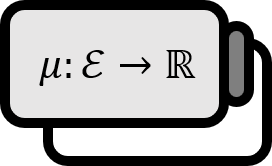Total Variation
Definition1
A total variation $| \nu |$ of a signed measure $\nu$ on a measurable space $(X, \mathcal{E})$ is defined as follows.
$$ |\nu |= \nu^{+} +\nu^{-} $$
Here, $\nu=\nu^{+}-\nu^{-}$ is the Jordan decomposition of $\nu$.
Explanation
$\nu^{+}$ and $\nu^{-}$ are called the positive variation and negative variation of $\nu$, respectively. The Jordan decomposition and the total variation for a measure are exactly the same as the method of expressing any function as two non-negative functions. The following holds for the total variation $|\nu|$.
Theorem 1
Let’s say $E \in \mathcal{E}$. Then, the two propositions below are equivalent.
- (a) $E$ is $\nu$-null.
- (b) $E$ is $|\nu|$-null.
Proof
(a) $\implies$ (b)
If $E$ is $\nu$-null, let’s say $X=P\cup N$ is a partition of $\nu$. Then, by assumption, the following holds for all $F\subset E$, $F\in \mathcal{E}$.
$$ \begin{align*} \nu^{+}(F) &= \nu (F \cap P)=0 \\ \nu^{-}(F) &= \nu (F \cap N)=0 \end{align*} $$
Therefore, the below equation is valid.
$$ | \nu | (F)= \nu^{+}(F) + \nu^{-}(F)=0,\quad \forall F\subset E $$
Thus, $E$ is $| \nu |$-null.
(b) $\implies$ (a)
If $E$ is $| \nu |$-null, then the following holds for all $F\subset E$, $F\in \mathcal{E}$.
$$ | \nu | (F)=\nu^{+} (F) +\nu ^- (F)=0 $$
However, since $\nu^{+}$, $\nu^{-}$ are mutually singular, for the above equation to hold, necessarily $\nu^{+} (F)=0$, $\nu^{-} (F)=0$ must be true. Therefore, we obtain the following.
$$ \nu (F) = \nu^{+} (F) - \nu^{-} (F)=0,\quad \forall F\subset E $$
Thus, $E$ is $\nu$-null.
■
It can be seen in the proof process that the equivalent condition is expanded as follows.
- (a) $E$ is $\nu$ -null.
- (b) $E$ is $|\nu|$ -null.
- (b’) $E$ is $\nu^{+}$ -null, $\nu^{-}$ -null.
Theorem 2
For two signed measures $\nu$, $\mu$, the conditions below are all equivalent.
- (c) $\nu \perp \mu$
- (d) $\nu^{+} \perp \mu$ and $\nu^{-} \perp \mu$
- (e) $|\nu| \perp \mu$
Proof
(c) $\implies$ (d)
By assumption, there exist $E \cup F =X$, $E \cap F=\varnothing$ where $E$ is $\nu$-null, and $F$ is $\mu$-null. Showing that $E$ is $\nu^{+}$-null, $\nu^{-}$-null according to the definition of mutually singular completes the proof. Since Theorem 1 establishes that if $E$ is $\nu$-null, it is also $\nu^{+}$-null, $\nu^{-}$-null, the following holds.
$$ \nu^{+} \perp \mu \quad \text{and} \quad \nu^{-} \perp \mu $$
■
(d) $\implies$ (e)
By assumption, $E_+$ is $\nu^{+}$-null, and there exist $E_+ \cup F_+ =X$, $E_+ \cap F_+=\varnothing$ where $F$ is $\mu$-null. Also, $E_-$ is $\nu^{-}$-null, and there exist $E_- \cup F_- =X$, $E_- \cap F_-=\varnothing$ where $F$ is $\mu$-null. Now, let’s define the set $A,\ B_{1},\ B_2,\ B_{3}$ as follows.
$$ A:= E_+ \cap E_-,\quad B_{1}:=E_+ \cap F_- \\ B_2:=F_+ \cap F_- ,\quad B_{3}:=E_- \cap F_+ $$
Then, the four sets are mutually exclusive and satisfy the following.
$$ A\cup B_{1} \cup B_2 \cup B_{3} =X $$
And $A$ is $\nu^{+}$-null and $\nu^{-}$-null. Therefore, $A$ is $| \nu |$-null. Also, for all $j$, $B_{j}$ is $\mu$-null. Let’s say $B=\cup B_{j}$. Then $A\cup B=X$, $A \cap B=\varnothing$ and since $A$ is $| \nu |$-null, $B$ is $\mu$-null, the following is valid.
$$ | \nu| \perp \mu $$
■
(e) $\implies$ (c)
Since $**
가정에 의해 $E$가 $| \nu |$-null이고, $F$가 $\mu$-null인 $E \cup F =X$, $E \cap F=\varnothing$가 존재한다. 정리 1 에 의해 $E$가 $| \nu |$-null이면 $\nu$-null" also holds, the proof is complete.
■
Gerald B. Folland, Real Analysis: Modern Techniques and Their Applications (2nd Edition, 1999), p ↩︎
